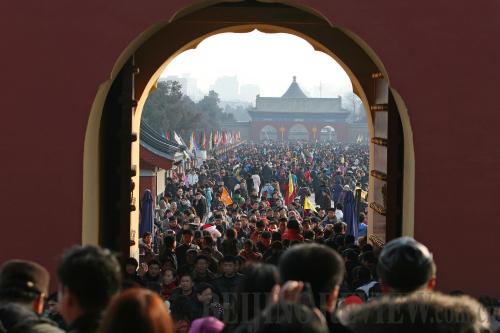|
 |
|
BUSY HOLIDAY: The Temple of Heaven is packed with tourists during the Spring Festival in 2011 (ZHUO ENSEN) |
According to the plan for Beijing's municipal development between 2004 and 2020, which was approved by the State Council, the number of permanent residents in Beijing should have been capped below 18 million until the end of 2020.
"People swarm to Beijing, Shanghai and other big cities because these cities are considered to have a more convenient life, brighter career opportunities and better public service facilities," said Mu. "But this is just not true due to the heavy traffic and many other problems caused by overpopulation."
Wang Jian, a water specialist with Green SOS, a Beijing-based environmental organization of university students, said the water availability in Beijing could only support at most 10 million people, or half of its current permanent residents.
Huang Yan, Director of the Beijing Municipal Commission of Urban Planning, said at a seminar on development problems in Beijing's population and industries in late May more research on population-related issues would be carried out.
The development mode of Beijing should be improved, as the city's population continued to grow and city life became less efficient, she said.
"The current municipal development plan, which sets targets for Beijing's economic and social development between 2004 and 2020, does not take into account the city's rapid urbanization process. It focuses more on city expansion and economic growth, but fails to offer a coordinated strategy to balance environmental protection and development," Huang said.
Zhang Zhixin, an associate professor at the Public Management Department of Capital University of Economics and Business, proposes to slice Beijing into several zones, each of which develops into big communities that have almost everything to satisfy people's life and entertainment, including cinemas, gyms, shopping malls.
"The layout of Beijing is quite unbalanced," said Zhang. "All the commercial areas are along the downtown Eastern Third Ring Road, while the south of Beijing is underdeveloped compared with the east. Now the problem is that everything is concentrated in the city center, especially central and local government offices. If we can scatter the offices around Beijing, life will be much easier."
Plans in action
In January 2011, downtown Xicheng District announced to launch a large-scale population relocation program in 2013, which is expected to relieve the population pressure of the capital city's heart and improve the living standards of residents. As the political and economic core area of Beijing, Xicheng is facing problems of high population density in cultural and historical heritage protection areas and a large number of shabby houses.
According to an official from the district's Housing Construction Commission, the population relocation plan will involve six residential communities, where some of the residents have to move out to decrease the population density.
After the population relocation is completed, more public service facilities will be introduced to the district to further develop its cultural industry and to improve local residents' living conditions.
In May 2011, the government of Tongzhou District, to the east of Beijing's central business district, said the construction of a "Tongzhou New City" had been proposed, where international organizations and multinational companies may set up their headquarters.
"This hopefully can both boost the regional economy and ease environmental and resource pressure on the capital's downtown area," said Zhang Hua, deputy chief of Tongzhou District.
Prior to that, in April 2009, Beijing chose Daxing, a suburban district in the city's south, as the location the No.2 Capital Airport to boost the economic development of south Beijing.
The construction of the airport is scheduled to be completed in 2015. "The new airport is designed to handle 40 million passengers annually," said Beijing's 12th Five-Year Plan (2011-15). "By 2015, the capital's total civil aviation capacity should reach 120 million passengers per year."
It will take half an hour to reach the new airport from downtown by car.
Chen Jinxin, a professor on urban planning at Hebei University, said the new airport would also help the development of Tianjin, north China's largest industrial city, and Hebei Province, the nearest province to Beijing.
Starting this year, Beijing and Hebei began working together on city planning programs.
"Beijing will have difficulties in solving its problems without cooperation from Tianjin and Hebei," said Chen.
Urban planning experts suggest, in the trilateral cooperation, Beijing will be positioned as an international city, famous cultural city and habitable city, and will give priority to the development of tertiary industry; Tianjin will be cast as an international port city, economic center in north China and habitable city; and Hebei will focus on building raw material and heavy chemical bases, modern agriculture bases, resort bases and manufacturing bases. | 